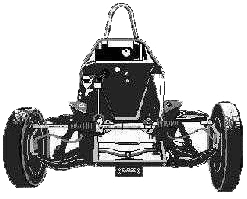
Skimmed the rear brake drum to get rid of the small ridge around the circumference, this not only allows the easier fitting and removal of the drum but also ensures a nice sure grip with the handbrake for the test and still pulls the car off the test rollers without further adjustment (Apart from any in it’s self-adjusting mechanism.) after three years.
With everything assembled it was time for the brake pipework and how much easier it is with the car lying there just waiting for your tender attention, although it still takes a bit of brainwork to position some of the twists and turns in a sensible, tidy and non-scuffable layout.
The test manual suggests that brake pipe should be supported with plastic clips at least every 30 cms, if memory serves, I marked this spacing out with chalk, stood back and looked at it, then re-adjusted to ‘even out’ the spacings with supports suitably close to the bends around corners.
I finished up with approximately 20 cm spacing on average, which ensured that it placed me well within the guidelines for a pass.
The compensator was adjusted as well as I could manage upon running tests later but required a few minutes patience from the tester on his brake testing machine to get right during the SVA test.
Following the guidelines in the brief notes I fitted my handbrake, cable and fuel tank then undersealed the whole lot. Incidentally, whenever I had to drill a small hole in the chassis (which I did not like doing but it is necessary now and then.) I always spray Waxoil into the hole to discourage rust.
I note also that I fitted the pedals and steering column whilst the car was still up-side-down.
Don’t tighten the steering ball joints or steering rack yet, you will need them apart to fit the engine and drive shafts later.
With all done on the underside I fitted the wheels and called for help. Two acquaintances from my local Chinese Take-Away eventually arrived (I’d still be waiting for friends or neighbours I think.) and in a few seconds it was off the barrels, turned over and rolled back in.
Now for one of the
most important things that you can do.
Find some scrap foam rubber, wrap it around the torsion bar fixing brackets at either side of the car and tape it securely. These padded lumps will save you so much agony and bad language as you trot to and fro during the build up. You only need to catch a shin once to know the wisdom of this advice.
Just send money.
Now I wasted a good amount of time fitting the heating system and relevant hosing. Without a good fan to blow the air it was ineffectual and has since been removed. Having driven it all through the first winter I did not suffer at all, it is warmer and more protected than a motor cycle. (I have thought up a better system, which may also help improve cooling I think, if anyone wants to know.)
The next couple of months were taken up with assembling the dash and interior detail such as seat belts, seats, wiring, fuel sender, mud guards, parcel shelf, rubber floor mats etc.
Hiring a hydraulic hoist, the engine was in within fifteen minutes, the easiest fit I have ever had.
Fitting the drive shafts, (Glad you left the joints loose?) gear selector rod and exhaust system brought the underneath pretty well done with the exception of filling the gear box with oil which requires setting the beast down on its feet again, unless you have the whole thing supported level on stands.
The engine was assembled with the delicate parts once more and the timing set up with the aid of a bulb on leads and the battery.
Once the weight of the engine is in place the wheels can be lined up. Learning from experience I have scrapped the recommended toe out and arrived at the parallel alignment producing the least uneven wear on the tyres.
I will not dishearten you by telling you how long I spent on the wiring, it need not have taken that long if I had completely rewired as had been my original intention. I thought that keeping to the loom and wiring diagrams would help me complete the job sooner for the time being.
The Haynes manual was wrong, the handbrake circuit is shown with earth connections at both ends, this does not work and once a positive supply is inserted in the circuit the rest of the system lights up like a Christmas tree.
Once all was connected and the dash lights seemed to be indicating that all was well and ready to fire up once the key was turned it seemed time to take one giant leap for a home mechanic.
Never liking thrashing batteries, waiting for fuel to be pumped from tank to carb, I made sure that the fuel system was primed beforehand and, hoping that long-unpractised skills were not deserting me now pulled the choke and turned the key.
What a moment as the engine turns for a heart stopping revolution or two as the fuel is breathed in then ‘wonder of wonders’, it fires and don’t we get a thrill out of revving the engine and listening to the mechanics to detect any miss-adjustment to those tappets or suspicious knocks.
Once warmed up and the choke goes all the way in, a turn or two on the throttle screw produces the satisfying sound of a smooth tick-over and throb of the exhaust.
Beats wallpapering the loo doesn’t it?
The rest of the build up is covered in my notes which I believe Mark has put on the web but which are always available to anyone that wants a copy, for a donation towards ink please. Happy building, Marten Bowtle.
acrobat file of 15MB